Related Research Articles

Mont Blanc is the highest mountain in the Alps and Western Europe, and the highest mountain in Europe outside the Caucasus mountains, rising 4,805.59 m (15,766 ft) above sea level, located on the French-Italian border. It is the second-most prominent mountain in Europe, after Mount Elbrus, and the 11th most prominent mountain summit in the world.

Chamonix-Mont-Blanc, more commonly known simply as Chamonix (Chamôni), is a commune in the Haute-Savoie department in the Auvergne-Rhône-Alpes region in Southeastern France. It was the site of the first Winter Olympics, held in 1924.

Horace Bénédict de Saussure was a Genevan geologist, meteorologist, physicist, mountaineer and Alpine explorer, often called the founder of alpinism and modern meteorology, and considered to be the first person to build a successful solar oven.

The Mer de Glace is a valley glacier located on the northern slopes of the Mont Blanc massif, in the French Alps. It is 7.5 km long and 200 metres (660 ft) deep but, when all its tributary glaciers are taken into account, it can be regarded as the longest and largest glacier in France, and the second longest in the Alps after the Aletsch Glacier.
I can no otherwise convey to you an image of this body of ice, broken into irregular ridges and deep chasms than by comparing it to waves instantaneously frozen in the midst of a violent storm.

The French Alps are the portions of the Alps mountain range that stand within France, located in the Auvergne-Rhône-Alpes and Provence-Alpes-Côte d'Azur regions. While some of the ranges of the French Alps are entirely in France, others, such as the Mont Blanc massif, are shared with Switzerland and Italy.

The Montenvers Railway or Chemin de fer du Montenvers is a rack railway line in the Haute-Savoie department of France. The line runs from a connection with the SNCF, in Chamonix, to the Hotel de Montenvers station, at the Mer de Glace, at an altitude of 1,913 m (6,276 ft).

Marc-Théodore Bourrit (1739–1819) was a genevois traveller and writer.

The Arve is a river in France, and Switzerland. A left tributary of the Rhône, it is 108 km (67 mi) long, of which 9 km in Switzerland. Its catchment area is 1,976 km2 (763 sq mi), of which 80 km2 in Switzerland. Its average discharge in Geneva is 79 m3/s (2,800 cu ft/s).
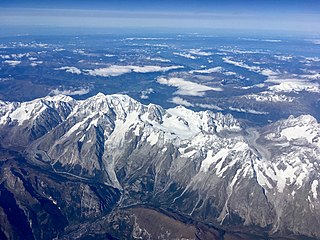
The Mont Blanc massif is a mountain range in the Alps, located mostly in France and Italy, but also straddling Switzerland at its northeastern end. It contains eleven major independent summits, each over 4,000 metres (13,123 ft) in height. It is named after Mont Blanc, the highest point in western Europe and the European Union. Because of its considerable overall altitude, a large proportion of the massif is covered by glaciers, which include the Mer de Glace and the Miage Glacier – the longest glaciers in France and Italy, respectively.

The Bossons Glacier is one of the larger glaciers of the Mont Blanc massif of the Alps, found in the Chamonix valley of Haute-Savoie département, south-eastern France. It is fed from icefields lying on the northern side of Mont Blanc, and descends down close to the Aiguille du Midi and ends on the southern side of the Arve valley, close to the town of Chamonix. It has the largest altitudinal drop of all the alpine glaciers in Europe, and formerly extended much further down the valley than it does today. It is now approximately 7.5 km long, with a surface area of approximately 10 km².

The Pierres du Niton are two glacial erratics in Lake Geneva, Switzerland, in Geneva harbor. On the left bank of the lake near Quai Gustave-Ador, they are remnants from the last ice age, left by the Rhone glacier. Because of their role in Swiss cartography, the rocks have been declared a "Geotope", a national site of geological heritage.
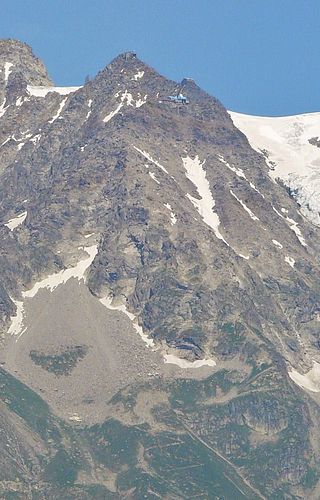
Pointe Helbronner is a mountain in the Mont Blanc massif in the Graian Alps on the watershed between France and Italy.

The Leschaux Hut is a refuge in the Mont Blanc massif in the Alps. It is located at 2,431 m on the north side of the Glacier de Leschaux – a tributary of the Mer de Glace. It is owned by the CAF and can accommodate up to 19 people. The hut is used as a base by mountaineers climbing peaks such as Grandes Jorasses, Petites Jorasses and Mont Mallet. It is accessed by going up the Mer de Glace from Montenvers, and then up the Glacier de Leschaux. The first refuge was built in 1929. It was enlarged to 30 seats in 1934, but destroyed by an avalanche in 1954. A new hut was built in 1968 and was enlarged in 2003.

The Mont Buet is a mountain of the Chablais Alps in Haute-Savoie, France. Mont Buet has played an important role in the history of science at the end of the eighteenth century when a series of Genevan scientists such as Jean-André Deluc, Horace Bénédict de Saussure or Marc-Auguste Pictet climbed to the summit to carry out scientific observations. Before the first successful ascents on the Mont Blanc in 1786, Mont Buet was "the highest among those accessible in this area" of the Alps. Mont Buet remains a popular destination especially because of the exceptional view on Mont Blanc, and the panoramic view from the summit.

The so-called Top of the Mont Blanc is a collection piece on display in the Oval Room of Teylers Museum. The specimen was cut off from the highest findable piece of exposed rock of the Rocher de la Tournette, 4,677 metres (15,344 ft) high on the snow covered summit ridge of the Mont Blanc on 3 August 1787, during one of the first climbs of the mountain by the Swiss scientific pioneer Horace Bénédict de Saussure.
Venance Payot was a naturalist, glaciologist, alpine mountain-guide, scholar, author, and two-time mayor of Chamonix, France. He published a wide range of early scientific literature relating to the mountains of the Mont Blanc massif and undertook some of the earliest continued measurements of the movement of glaciers within that mountain range. He has been posthumously credited in mountaineering literature with being the youngest person to have climbed Mont Blanc, and would have been sixteen years old at the time; other sources have challenged this.
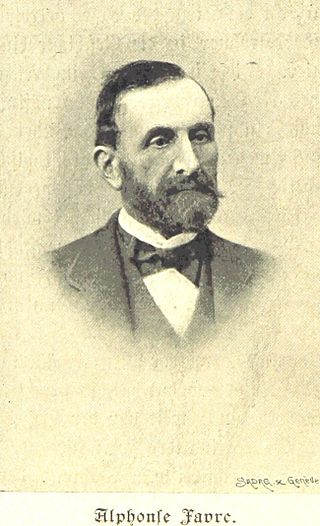
Jean Alphonse Favre was a Swiss geologist. He was a pioneer of alpine geology and became director of the Swiss Geological Commission (Schweizerische Geologische Kommission), which was charged with creating the geological map of Switzerland.
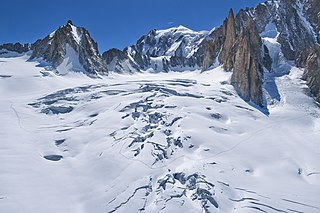
The Géant Glacier is a large glacier on the French side of the Mont Blanc massif in the Alps. It is the main supplier of ice to the Mer de Glace which flows down towards Montenvers. It gets its name from the nearby Dent du Géant.

The Col du Géant at 3,356 m (11,010 ft) is the main passage of the Mont Blanc massif between Courmayeur in the Aosta Valley and Chamonix-Mont Blanc in the Arve Valley. On the French side, to the north is the Géant Glacier which overlooks the Mer de Glace.
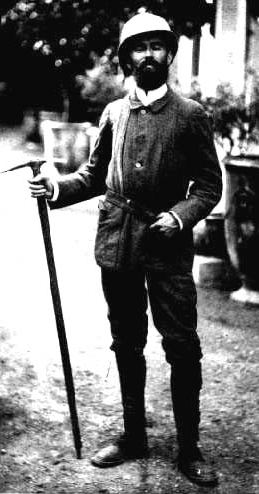
Joseph Vallot was a French scientist, astronomer, botanist, geographer, cartographer and alpinist and "one of the founding fathers of scientific research on Mont Blanc". He is known mainly for his fascination with Mont Blanc and his work in funding and constructing a high-altitude observatory below its summit, and for the many years of study and research work that he and his wife conducted both there, and at their base in Chamonix. The observatory and adjacent refuge that he constructed for use by mountain guides and their clients attempting the Mont Blanc summit both still bear his name today, despite being rebuilt in modern times.
References
- ↑ Baedeker, Karl. South-eastern France including Corsica: handbook for travellers. Leipsic: Karl Baedeker, 1898. Google Books. Web. 28 February 2011.
- ↑ De Saussure, Horace-Bénedict. Voyages Dans les Alpes, Précédés d’un Essai sur l’Histoire Naturelle des Environs de Geneve. Geneva, Switzerland: Barde, Manget & Compagnie, 1786. Gallica.bnf.fr. Web. 12 Feb. 2011.
- ↑ "Journals of Anne Lister, SH:7/ML/E/17/0051".
- ↑ "Journal of Ann Walker, WYC:1525/7/1/5/1/0013".
- ↑ Moore, John. Lettres d’un Voyageur Anglois sur la France, la Suisse et ’Allemagne. Geneva, Switzerland: Isaac Bardin, 1781. Gallica.bnf.fr. Web. 12 Feb. 2011.
- ↑ Bourrit, Marc-Théodore. A relation of a journey to the glaciers in the Dutchy of Savoy. Dublin: printed for R. Cross, D. Chamberlain, J. Hoey, J. Potts, J. Williams [and eight others], 1776. ECCO. Web. 15 Feb. 2011.
- ↑ Coxe, William. Travels in Switzerland, and in the country of the Grisons: in a series of letters to William Melmoth, Esq; from William Coxe…In three volumes. London: printed for T. Cadell, in the Strand, 1791. ECCO. Web. 15 Feb. 2011.
- ↑ Owen, John. Travels into different parts of Europe, in the years 1791 and 1792. With familiar remarks on places-men-and manners. London: printed for T.Cadell jun, and W. Davies, 1796. ECCO. Web. 15 Feb. 2011.